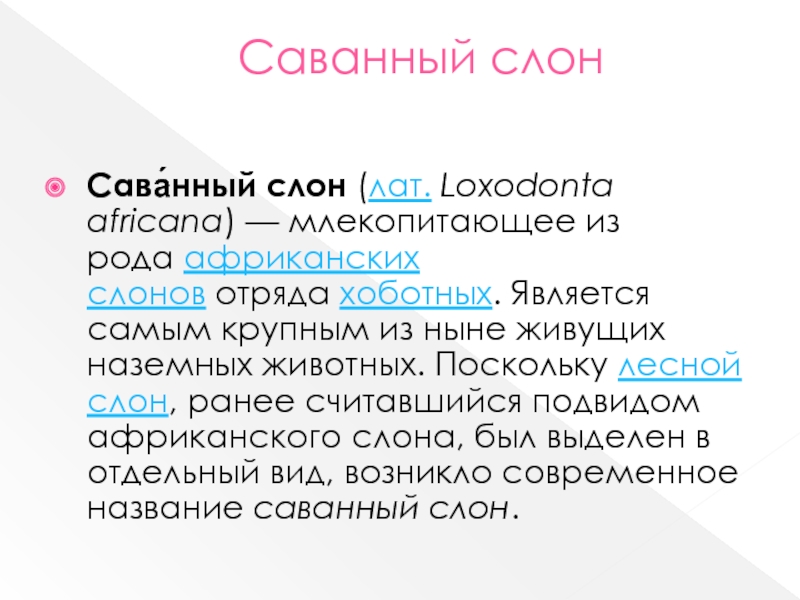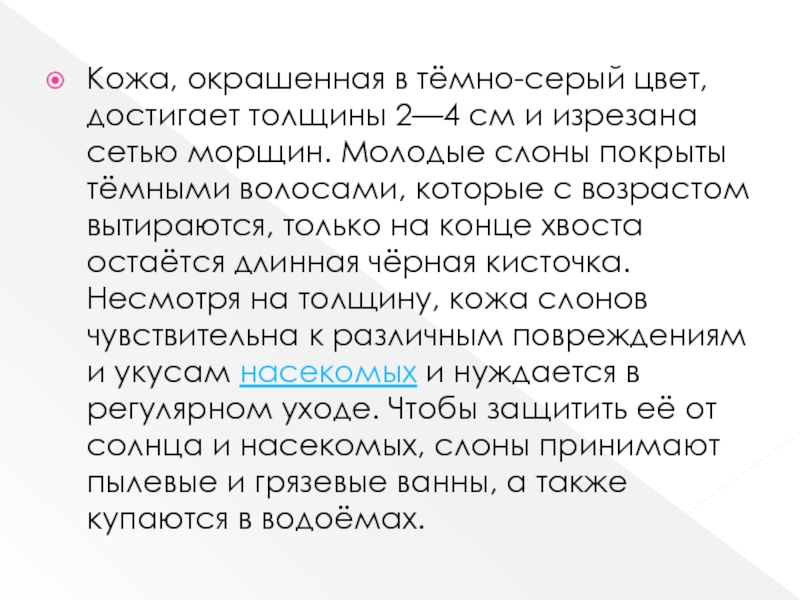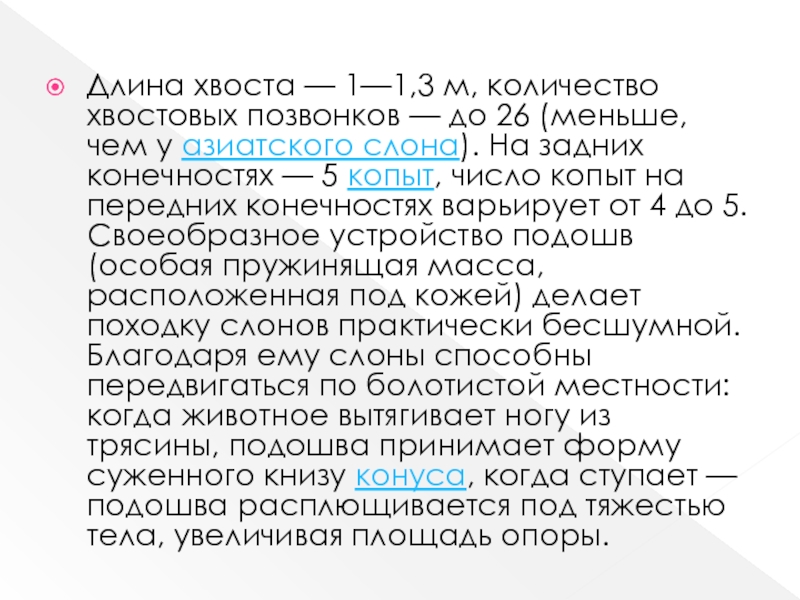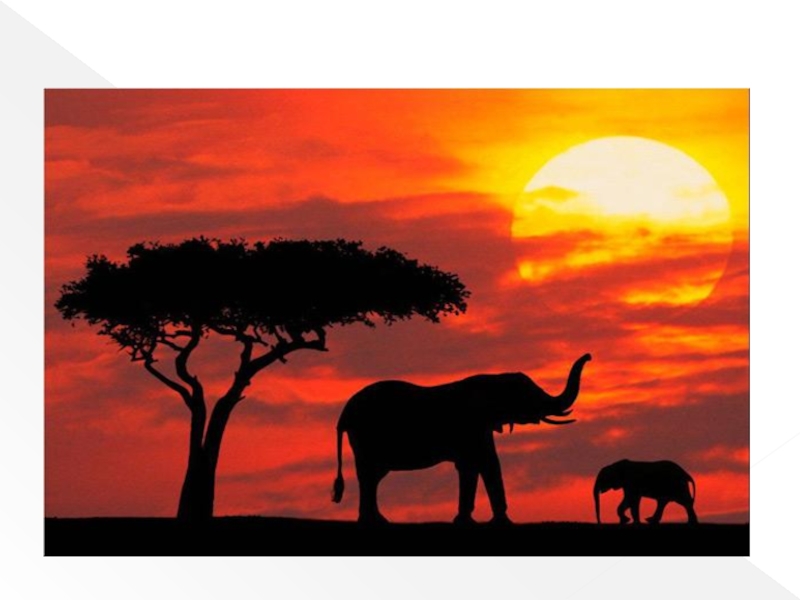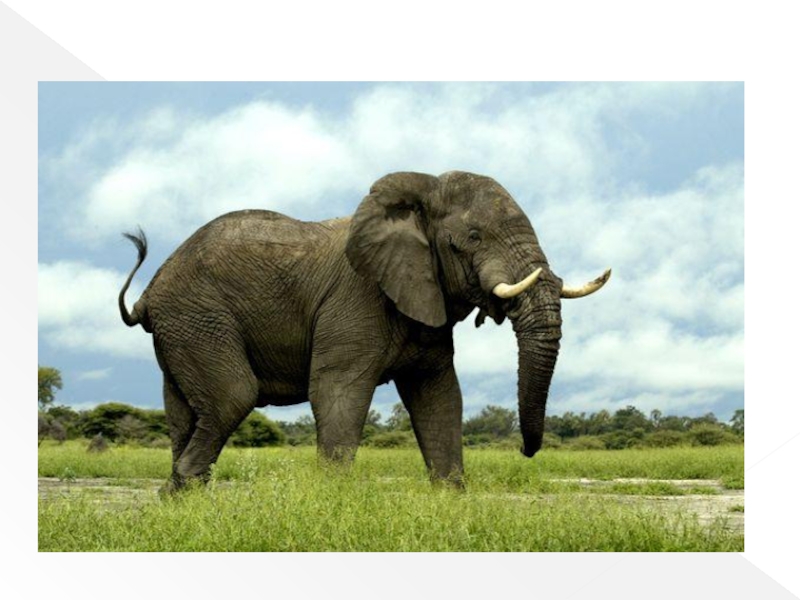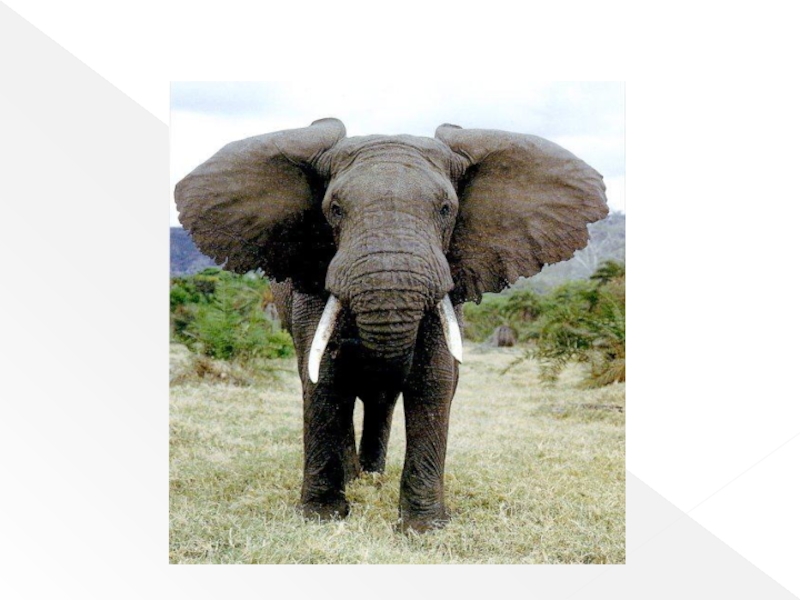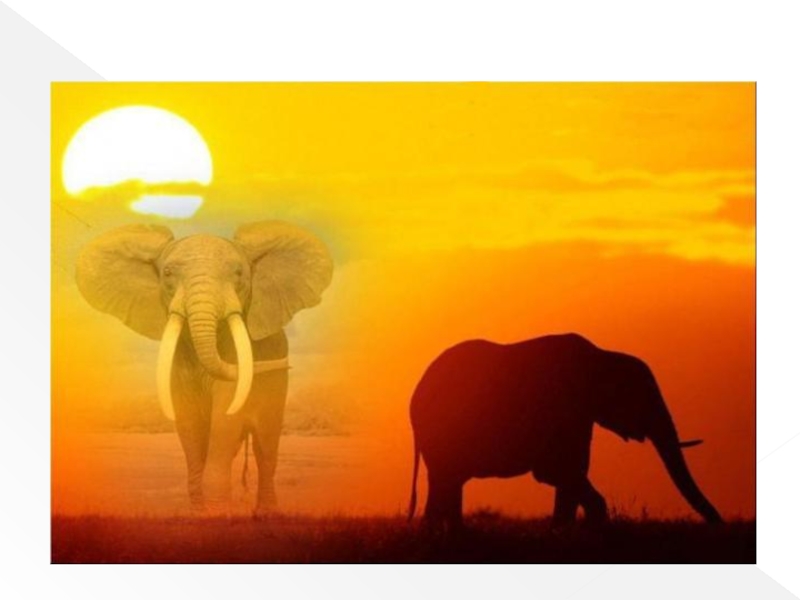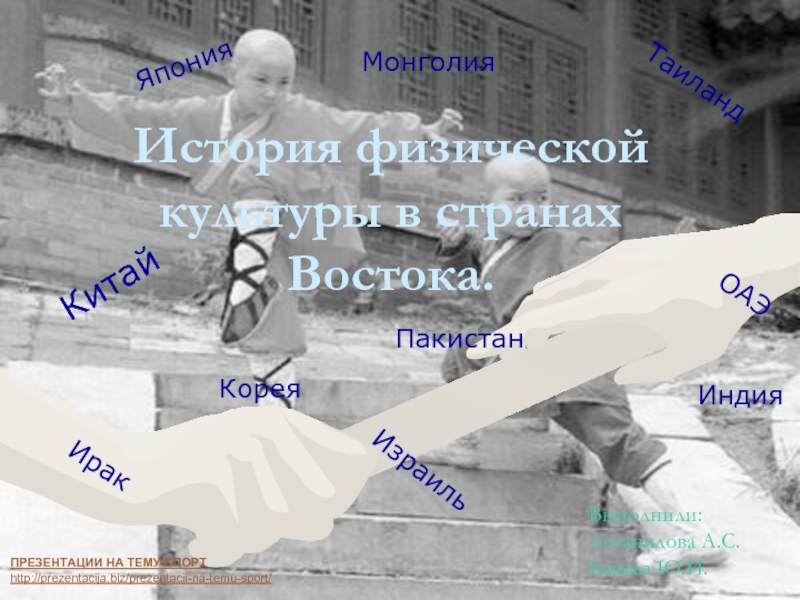Разделы презентаций
- Разное
- Английский язык
- Астрономия
- Алгебра
- Биология
- География
- Геометрия
- Детские презентации
- Информатика
- История
- Литература
- Математика
- Медицина
- Менеджмент
- Музыка
- МХК
- Немецкий язык
- ОБЖ
- Обществознание
- Окружающий мир
- Педагогика
- Русский язык
- Технология
- Физика
- Философия
- Химия
- Шаблоны, картинки для презентаций
- Экология
- Экономика
- Юриспруденция
А frican elephant
Содержание
- 1. А frican elephant
- 2. Саванный elephantСаванный elephant (lat. E loxodonta africana)
- 3. The appearance of theСаванный elephant is characterized
- 4. The TusksSexual dimorphism is expressed not only
- 5. TrunkThe trunk is a long flexible process,
- 6. Other featuresHuge ears (the length from the
- 7. Leather, painted in dark-grey color, reaches a
- 8. Tail length, 1-1,3 m, the number of
- 9. Dissemination OfHistorically, the area of the african
- 10. Слайд 10
- 11. Слайд 11
- 12. Слайд 12
- 13. Слайд 13
- 14. Саванный слон Сава́нный слон (лат. Loxodonta africana) — млекопитающее из
- 15. Внешний вид Саванный слон характеризуется массивным тяжёлым
- 16. Бивни Половой диморфизм выражен не только в массе
- 17. Хобот Хобот представляет собой длинный гибкий отросток, образованный
- 18. Другие особенности Огромные уши (длиной от основания
- 19. Кожа, окрашенная в тёмно-серый цвет, достигает толщины
- 20. Длина хвоста — 1—1,3 м, количество хвостовых позвонков — до
- 21. Распространение Исторически ареал африканского слона простирался по
- 22. Слайд 22
- 23. Слайд 23
- 24. Слайд 24
- 25. Слайд 25
- 26. Слайд 26
- 27. Слайд 27
- 28. Слайд 28
- 29. Слайд 29
- 30. Конец
- 31. Скачать презентанцию
Саванный elephantСаванный elephant (lat. E loxodonta africana) is a mammal of genus of african elephants detachment хоботных. Is the largest of the living land animal. As the forest elephant, previously considered
Слайды и текст этой презентации
Слайд 3The appearance of the
Саванный elephant is characterized by a massive
heavy body, big head on a short neck, thick-limbed, big
ears, upper teeth, have become the tusks, long, muscular trunk.According to the "Guinness Book of records", it is the largest terrestrial mammal. The biggest specimen ever recorded in the Book of records was a male, застреленный November 7, 1974 in Мукуссо (Angola), its weight was 12,24 t.
Body length reaches 6-7,5 meters, the height at the shoulder (the highest point of the body) - 2,4-3.5 m. The average weight of female 2.8 tons, males - 5 tons.
Слайд 4The Tusks
Sexual dimorphism is expressed not only in body weight,
but also in the amount of tusks - males they
are significantly larger: its length is 2.4-2.5 m in weight up to 60 kg. The largest of the known tusks reached 4.1 m with a weight of 148 kg, however, the most serious of the tusks were the elephant, who was assassinated in 1898 in Kilimanjaro, at 225 kg. The tusks continue to grow throughout the life of the elephant and serve as an indicator of its age. Apart from the tusks of an elephant only 4-6 indigenous teeth, which in the course of life were replaced as wear. When changing the new teeth grow up not under the old, and then to the jaw, gradually pushing old teeth forward. Molars are very large, weighing up to 3.7 kg with a length of 30 cm and a width of 10 cm. Change them 3 times during the life of an elephant: in 15 years, the milk teeth are replaced by permanent, following the change of teeth is happening in the 30 and 40 years. The last teeth wear down to 65-70 years, after which the animal is not able to eat normally and die from exhaustion.Just as people are right hand and left hand, different elephants often use the right or the left tusk. This can be determined by the degree of wear tusk and his more скругленному the tip.
Слайд 5Trunk
The trunk is a long flexible process, educated accrete between
the nose and the upper lip. The african elephant trunk
ended at the 2 arms, дорсальным and вентральным. The usual length of a trunk is about 1,5 m, weight - 135 kg. Through a complex system of muscles and tendons of the trunk has a great mobility and strength. With its help the elephant is pick up a small object, so and raise the weight of the 250-275 kg. Elephant's trunk is able to maintain a 7.5 liters of water.Слайд 6Other features
Huge ears (the length from the bottom to the
top 1.2-1.5 m) are evolutionary adaptation to the hot climate.
Due to the large area and developed the blood supply they help the elephant get rid of excess heat. Moving the ears, elephants using them as a fan.Figure veins on the surface of ears of an elephant as individual as fingerprints in humans. With its help it is possible to identify an elephant. Help in the identification well as holes and broken on the edges of the ears.
Слайд 7Leather, painted in dark-grey color, reaches a thickness of 2-3
cm and cut up a network of wrinkles. Young elephants
are covered with dark hair, which with the age of the lost, only at the end of the tail remains a long black brush. Despite the thickness of the skin elephants sensitive to a variety of damage and the bites of insects and needs regular care. To protect it from the sun and insects, elephants take a dust and mud baths, and bathe in water bodies.Слайд 8Tail length, 1-1,3 m, the number of caudal vertebrae -
up to 26 (less than the asian elephant). On the
rear extremities - 5 hooves, the number of hooves on the front legs varies from 4 to 5. A peculiar device soles (special spring mass, located under the skin) makes the walk elephants almost silent. Thanks to him, the elephants are able to move through the swampy areas: when the animal hold her foot out of the quagmire, the sole takes the form of a narrowed to the bottom of the cone, when walking is the sole flattened under the weight of the body, increasing the footprint.Слайд 9Dissemination Of
Historically, the area of the african elephant stretched across
sub-Saharan Africa. In antiquity it (or a separate type of
e loxodonta pharaonensis) was also in North Africa, but completely extinct even in the VI century bc. e. At the present time almost continuous in the past the area is strongly broken, especially in West Africa. The area of the elephants declined from 30 million km2 to 5.3 million km2 (2003). African elephant completely extinct in Burundi, Gambia and Mauritania (IUCN 2004).[4] the Northern border of the area coincides approximately with 16.4 per degree c. w., isolated population has been preserved to the north, Mali. Despite the vast area of distribution, the elephants are concentrated mostly in national parks and reserves.Слайд 14Саванный слон
Сава́нный слон (лат. Loxodonta africana) — млекопитающее из рода африканских слонов отряда хоботных. Является самым
крупным из ныне живущих наземных животных. Поскольку лесной слон, ранее считавшийся
подвидом африканского слона, был выделен в отдельный вид, возникло современное название саванный слон.Слайд 15Внешний вид
Саванный слон характеризуется массивным тяжёлым телом, большой головой на
короткой шее, толстыми конечностями, огромными ушами, верхними резцами, превратившимися в бивни,
длинным мускулистым хоботом.Согласно «Книге рекордов Гиннесса», это самое крупное наземное млекопитающее. Самым крупным экземпляром из когда-либо зарегистрированных в Книге рекордов был самец, застреленный 7 ноября 1974 года в Мукуссо (Ангола), его вес составил 12,24 т.
Длина тела достигает 6—7,5 м, высота в плечах (наивысшая точка тела) — 2,4—3,5 м. Средняя масса тела у самок 2,8 т, самцов — 5 т.
Слайд 16Бивни
Половой диморфизм выражен не только в массе тела, но и в
размерах бивней — у самцов они значительно крупнее: их длина составляет
2,4—2,5 м при весе до 60 кг. Самый крупный из известных бивней достигал 4,1 м при весе 148 кг, однако самые тяжёлые бивни были у слона, убитого в 1898 году у Килиманджаро, — по 225 кг. Бивни продолжают расти на протяжении всей жизни слона и служат индикатором его возраста. Помимо бивней у слона всего 4—6 коренных зубов, которые в течение жизни сменяются по мере изнашивания. При смене новые зубы вырастают не под старыми, а дальше на челюсти, постепенно оттесняя старые зубы вперёд. Коренные зубы очень велики, весом до 3,7 кг при длине 30 см и ширине 10 см. Меняются они 3 раза в течение жизни слона: в 15 лет молочные зубы сменяются постоянными, следующая смена зубов происходит в 30 и в 40 лет. Последние зубы изнашиваются к 65—70 годам, после чего животное теряет возможность нормально питаться и умирает от истощения.Слайд 17Хобот
Хобот представляет собой длинный гибкий отросток, образованный сросшимися между собой носом и верхней
губой. У африканского слона хобот оканчивается 2 отростками, дорсальным и
вентральным. Обычная длина хобота — около 1,5 м, вес — 135 кг. Благодаря сложной системе мускулов и сухожилий хобот обладает большой подвижностью и силой. С его помощью слон способен как подобрать мелкий предмет, так и поднять груз весом в 250—275 кг. Хобот слона способен удержать в себе 7,5 литра воды.Слайд 18Другие особенности
Огромные уши (длиной от основания до вершины 1,2—1,5 м) являются
эволюционным приспособлением к жаркому климату. За счёт большой площади и
развитого кровоснабжения они помогают слону избавляться от избытка тепла. Двигая ушами, слоны обмахиваются ими, как веером.Рисунок вен на поверхности ушей слона так же индивидуален, как и отпечатки пальцев у человека. С его помощью можно идентифицировать слона. Помогают в идентификации также дыры и надрывы на краях ушей.













